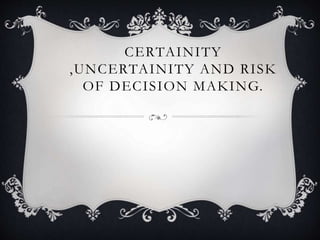Certainity ,uncertainity and risk of decision making
•Download as PPTX, PDF•
2 likes•1,463 views
Report
Share
Report
Share

Recommended
Recommended
More Related Content
What's hot
What's hot (20)
Risk & Uncertainty in Managerial Decision Making (Managerial economics)

Risk & Uncertainty in Managerial Decision Making (Managerial economics)
Viewers also liked
You have probably asked at one time or another: Is your IT department headed in the right direction? Is it aligned with where the rest of the company is going?
In this presentation, Dr. Jim Anderson takes a proven business communication, measurement, and strategy tool – The Balanced Scorecard – and shows you how to apply it to the unique needs of IT.
There is no question that The Balanced Scorecard works; estimates show that 60% of the Fortune 1000 have a Balanced Scorecard in place.
Many successful organizations have already shown that The Balanced Scorecard allows your IT department to have a single, focused, strategy that the entire staff can rally behind. Dr. Jim will tell you how to do it!
For more information on Dr. Jim Anderson and his company, Blue Elephant Consulting, find out more on the web at http://www.BlueElephantConsulting.com Using A Balanced Scorecard For An IT Department -- The Secret To Knowing Wher...

Using A Balanced Scorecard For An IT Department -- The Secret To Knowing Wher...Blue Elephant Consulting
Managing Uncertainty to Improve Decision Making - Statistical Thinking for Quality Control and ImprovementManaging Uncertainty to Improve Decision Making - Statistical Thinking for Qu...

Managing Uncertainty to Improve Decision Making - Statistical Thinking for Qu...Prof. Dr. Diego Kuonen
Viewers also liked (20)
Inroduction to Decision Theory and Decision Making Under Certainty

Inroduction to Decision Theory and Decision Making Under Certainty
Mediabahasa inggris asking and giving certainty kelas IX SMP

Mediabahasa inggris asking and giving certainty kelas IX SMP
46-the-strategy-for-public-finance-management-reforms-in-kenya-2013-2018

46-the-strategy-for-public-finance-management-reforms-in-kenya-2013-2018
Using A Balanced Scorecard For An IT Department -- The Secret To Knowing Wher...

Using A Balanced Scorecard For An IT Department -- The Secret To Knowing Wher...
Managing Uncertainty to Improve Decision Making - Statistical Thinking for Qu...

Managing Uncertainty to Improve Decision Making - Statistical Thinking for Qu...
Similar to Certainity ,uncertainity and risk of decision making
Similar to Certainity ,uncertainity and risk of decision making (20)
Payback model of risk management by Dr. B. J. Mohite

Payback model of risk management by Dr. B. J. Mohite
Supervision of Instruction and Analysis of Teaching Report.pptx

Supervision of Instruction and Analysis of Teaching Report.pptx
More from kagil
More from kagil (12)
Certainity ,uncertainity and risk of decision making
- 1. CERTAINITY ,UNCERTAINITY AND RISK OF DECISION MAKING.
- 2. CERTAINITY By conditions of certainity ,we mean that the decision maker can specify the consequences of a particular decision ,or act . Of course , certainity about future events is difficult and managerial decisions must be made in awareness that future conditions may vary widely from those contemplated when the decision is being made . Nevertheless , many managerial decisions may be made in conditions approaching cetainity. Decision –making under certainity may seem trival ,but as the number of possible alternatives increases ,finding the one with the highest pay –off becomes more and more difficult .
- 3. RISK In decision –making under conditions of risk , the consequences of a particular decision cannot be specified with known probability values . The value of the probability associated with the event is a measure of the likelihood of the occurrence of that event . Evaluation of alternatives is done by calculating the expected pay off associated with each alternative. The expected pay off associated with each alternative is the sum of the value of each possible outcome times its associated probability . As a decision- making ,the use of this approach maximises the expected pay off.
- 4. UNCERTAINITY More prevalent than either conditions of certainity or risk are conditions of uncertainity . Uncertainity exists when the decision-maker does not know the probabilities associated with the possible outcomes , through he has been able to identify the possible outcomes and their related pay offs . This is not the same as decision-making under conditions of complete ignorance , in which even the possible outcomes and their pay-off cannot be identified . Since pay offs are identified but probabilities are unknown under conditions of uncertainity , the criterion of maximising the expected pay off cannot be used in evaluating the decision alternatives , or acts .Three other bases that can be used , however are the maximin , maximax and minimax regret citeria .
- 5. MAXIMIN If the manufacturer is pessimistic or cautious in his approach , he can choose that decision act which maximises the minimum pay off . This is called the maximin criterion .
- 6. MAXIMAX If the manufacturer is optimistic , he may choose that decision act which maximises the maximum pay off . This is called maximax.
- 7. MINIMAX REGRET The third possible criterion , called minimax regret , looks at the decision problem from the point of view that is niether pessimistic nor as optimistic as the maximin and maximax criteria , respectively. As the name implies the minimax –regret criterion is the one by which the decision maker minimises the maximum regret that can occur , no matter what the outcome .